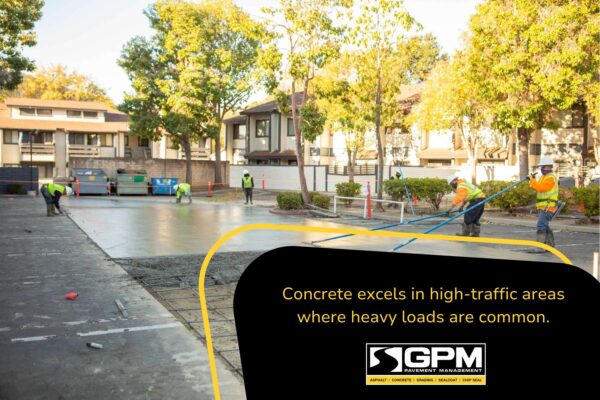Are you struggling to decide whether concrete or asphalt best meets your hard surfacing needs? We dive into the pros and cons of both in this article.
At General Pavement Management (GPM), we understand that this choice isn’t one-size-fits-all. We want to assist you in making an informed decision that aligns perfectly with your unique requirements. Thus, we won’t be declaring an ultimate winner, as both concrete and asphalt have their strengths and weaknesses. Instead, we’ll provide you with a comprehensive and balanced comparison, taking into account various critical factors.
Whether you’re a homeowner looking to upgrade your driveway or a business owner planning a parking lot renovation, this guide will empower you to make the right choice for your specific project. Let’s pave the way to a well-informed decision together.

Understanding Concrete
Concrete, often referred to as the bedrock of modern infrastructure, plays a crucial role in our everyday lives. Before we dive into the nitty-gritty of choosing between concrete and asphalt, let’s first understand what concrete is.
Defining Concrete
At its core, concrete is a composite material composed of several key components. The primary ingredients include Portland cement, water, and aggregates such as sand and gravel. When these elements combine, they undergo a chemical transformation, resulting in a hardened and durable material.

The Scientific Aspects of Concrete
Creating concrete is a precise science. The cement, typically Portland cement, acts as a binder, binding the aggregates together. Water serves as the catalyst for a chemical reaction called hydration, which causes the mixture to solidify and harden over time. The curing process ensures that concrete achieves its full strength and durability potential.
General Characteristics of Concrete
Concrete boasts remarkable qualities, making it a popular choice for various applications. It’s particularly known for its exceptional compressive strength. This makes it ideal for areas with heavy traffic, such as highways and industrial zones. Moreover, concrete exhibits remarkable durability, resisting wear and tear for many years.
As we explore the benefits and drawbacks of concrete in the upcoming sections, understanding its composition and scientific aspects will provide you with a solid foundation for making an informed choice between concrete and asphalt.
Unveiling Asphalt
While concrete is a sturdy and enduring choice for pavements, asphalt offers an intriguing alternative. Let’s peel back the layers and explore what makes asphalt a compelling option.
Defining Asphalt
Asphalt, also known as bitumen, is a dark and viscous substance derived from crude oil. This oil serves as the binding agent in asphalt pavement. When mixed with aggregates like crushed stone, sand, and gravel, it forms a cohesive material suitable for various paving applications.
The Scientific Aspects of Asphalt
The production of asphalt is a fascinating blend of chemistry and engineering. It involves the distillation of crude oil to extract bitumen, which is then mixed with aggregates to create asphalt. The result is a material suitable for paving roads and driveways. It’s flexible, weather-resistant, and has adhesive properties that make it smooth.

Key Features of Asphalt
Asphalt offers a set of unique characteristics. Its flexibility allows it to adapt to slight shifts in the underlying surface. This makes it less prone to cracking in regions with freeze-thaw cycles than concrete. Moreover, it is relatively quicker and more cost-effective to install than concrete. However, it does require periodic maintenance to ensure longevity. Such maintenance includes resealing and patching.
In the upcoming sections, we will delve deeper into the pros and cons of asphalt, shedding light on its suitability for various situations. Now that you have a basic understanding of its composition, scientific aspects, and distinct features, you will be able to make a better-informed decision when choosing between concrete and asphalt for your pavement needs.
Pros and Cons of Concrete
While many have chosen concrete for their pavement, it’s not without its drawbacks. Let’s explore the pros and cons of using concrete for your pavement needs.
Advantages of Concrete
Concrete’s durability is a standout feature. It can withstand heavy loads without significant deformation, making it ideal for areas with substantial traffic. Additionally, concrete boasts impressive longevity, often outlasting asphalt. It’s also resistant to the effects of ultraviolet (UV) rays. In regions with intense sun exposure, concrete is an excellent choice. If you wish to reduce skidability, concrete’s smooth surface is perfect for the job. That’s why engineers like to put it on airport runways and industrial floors.
Disadvantages of Concrete
One notable drawback is the higher upfront cost required to install concrete. It’s labor-intensive and requires careful preparation, contributing to a more substantial initial investment. Furthermore, concrete is susceptible to cracking. This is especially true in regions with frequent freeze-thaw cycles or expansive clay soils. Not only can cracks be unsightly, but repairs can be costly if you wish to maintain its appearance and integrity.
As you weigh the pros and cons of concrete, consider your specific needs, budget, and local climate. While it offers durability and strength, don’t forget about the potential drawbacks when making your pavement choice.
Pros and Cons of Asphalt
Now let’s dive into the pros and cons of opting for asphalt in your pavement projects.
Benefits of Asphalt
One of the most appealing aspects of asphalt is its cost-effectiveness. Asphalt installation tends to be more budget-friendly than concrete. This makes it an attractive choice for projects with limited funds. Furthermore, asphalt pavements can be constructed relatively quickly, minimizing disruptions and downtime. It doesn’t end there, though. Maintenance is straightforward, and you have the ability to repair specific sections rather than resurfacing entire areas. This feature is particularly advantageous for parking lots and roadways that endure heavy wear and tear.

Drawbacks of Asphalt
One of the primary drawbacks of asphalt is its relatively shorter lifespan. While it offers flexibility, it can be more susceptible to weathering. As you can imagine, areas with extreme temperature fluctuations may not fare so well with asphalt. Prolonged exposure to the sun’s UV rays can cause asphalt to become brittle and prone to cracking. In short, asphalt requires more frequent maintenance, including resealing and patching, to extend its lifespan and maintain its appearance.
When considering asphalt for your pavement needs, evaluate the trade-offs. While the lower upfront costs and ease of repair are compelling advantages, be mindful of the maintenance requirements and potential weather-related challenges. These can impact the longevity of your asphalt pavement.
Factors Affecting Concrete and Asphalt
When choosing between concrete and asphalt for your pavement project, you’ll want to factor in several key elements that can significantly influence the outcome.
1. Weather Conditions
Climate plays a pivotal role in determining whether concrete or asphalt is the better choice. In regions with extreme temperature fluctuations, concrete may be more susceptible to cracking. Asphalt, on the other hand, tends to flex with these variations. This makes it a suitable option for areas with such weather conditions. But don’t forget that excessive exposure to UV radiation can cause asphalt to deteriorate over time. Concrete can endure prolonged sun exposure.
2. Topography
The terrain, elevation, and drainage of your location are crucial considerations. On sloped surfaces, water drainage is essential to prevent erosion and the accumulation of moisture beneath the pavement. Asphalt’s flexibility and water resistance make it a good option for sloped areas. In contrast, concrete can be more challenging to adapt to uneven terrain. It requires effective drainage planning.
3. Traffic Load
The volume and weight of vehicle traffic are also key factors. Concrete excels in high-traffic areas where heavy loads are common. This is because it is exceptionally strong and durable. Asphalt’s cost-effectiveness and ease of repair make it an attractive choice for areas with a lower traffic load.

4. Maintenance Costs
Maintenance requirements can vary based on location and usage. Concrete typically demands less maintenance in terms of sealing and patching. Asphalt surfaces may require periodic resealing and repairs to combat weathering and wear.
As you can see, concrete or asphalt is not a one-size-fits-all response. Keep climate, topography, usage, and the amount of maintenance you’re willing to do in mind as you make your choice.
Concrete vs. Asphalt: How to Choose the Right Material for You
Now that you understand the difference between concrete and asphalt and the factors that affect them, which one is right for you? Here’s a roadmap to help you make the right choice:
1. Assess Your Specific Needs
Begin by evaluating the key requirements of your project. Do you expect a lot of traffic? How do you intend to use the area (e.g., residential driveway, commercial parking lot, or industrial road)? What are the environmental conditions in your location? Identifying your project’s specific demands is a crucial first step.

2. Consider Your Budget
As always, budget plays a significant role in the decision-making process. Concrete and asphalt have different cost structures. Asphalt tends to offer a more budget-friendly initial investment. However, it requires more long-term maintenance costs. Don’t forget about that when evaluating the overall financial impact.
3. Review the Climate and Weather
Take into account your region’s climate, including temperature fluctuations, precipitation, and UV exposure. If you’re in an area prone to extreme weather conditions, such as freeze-thaw cycles, you may opt for asphalt. If you’re in an area with high temperatures, concrete is probably the better way to go.
4. Consult with Experts
Don’t hesitate to seek advice from professionals. Their expertise can provide invaluable insights tailored to your specific project. This is especially true for local professionals who understand whether concrete or asphalt is better for your specific application and climate.
In the end, your choice between concrete and asphalt should align with your specific needs, budget, and the local environment. Pave the path to success with confidence, and remember that we at General Pavement Management are here to support you every step of the way.
We offer a variety of asphalt paving and concrete services, including:
Basically, if it has to do with pavement, we do it!
Contact GPM today to learn more about our asphalt paving services. We look forward to hearing from you!
